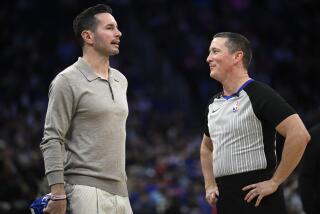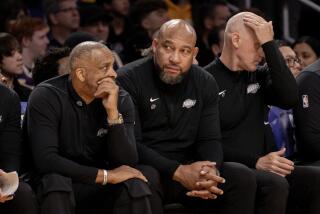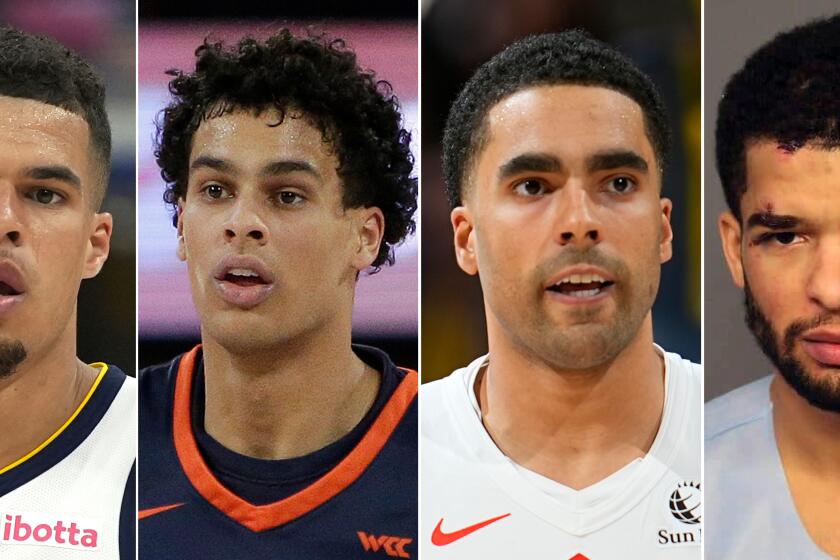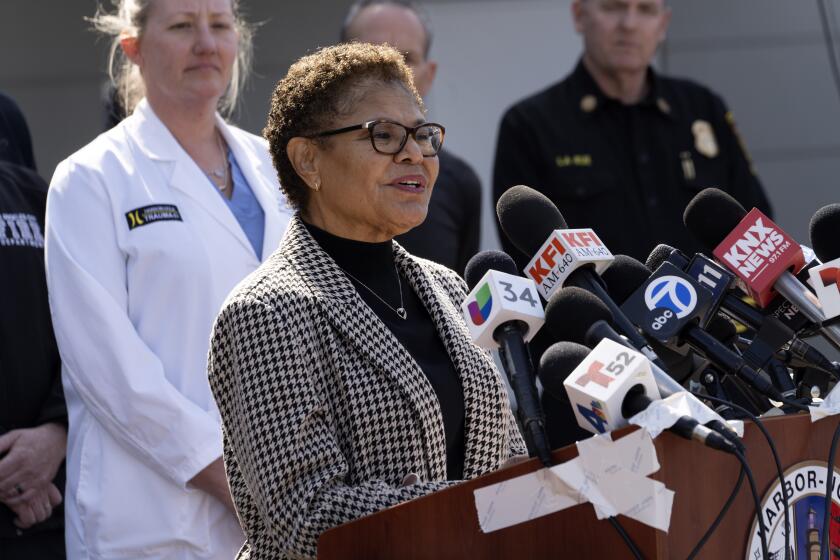HOOP DREAMS
Irvine Mayor Christina Shea received a curious telephone call last fall.
The caller told Shea he represented an NBA team interested in moving to the city, though he declined to identify himself or the team. Sketchy as it was, it resuscitated spirits in the offices of the Arrowhead Pond of Anaheim.
The Pond desperately seeks an NBA team to staunch the flow of red ink. The Ogden Corp. opened the arena five years ago and has bled money ever since, despite a full schedule of Mighty Duck games, concerts and events.
Tony Guanci, a Newport Beach resident and a sports industry consultant, was that mystery caller. In subsequent meetings with Irvine officials, Guanci identified himself but did not disclose that his advisory work was on behalf of the minority owners of the Sacramento Kings.
With Irvine unlikely to attract the corporate dollars to build an arena, Guanci’s call has Ogden grasping at a faint hope of luring the NBA tenant that would reduce--and could eliminate--the losses.
Jim Thomas, a Los Angeles developer and the Kings’ majority owner, says he isn’t moving the team, citing a 30-year loan agreement he signed with the city of Sacramento last year. But the minority owners, the Maloof family of New Mexico, can buy out Thomas’ interest within five years and could consider using an escape clause that allows the Kings to depart without financial penalty.
The Maloofs concluded negotiations to buy into the Kings earlier this year--with Guanci as an advisor-- sparking anxiety in Sacramento that the family would move the team at its first opportunity. The Maloofs deny such speculation.
Of the few NBA teams Ogden could pursue, the Kings make the most sense. With a small media market dooming Sacramento to limited revenues, a move to Orange County would make financial sense.
Ogden courted Clipper owner Donald Sterling for years, more wishing than expecting he would move his team from part-time to full-time tenancy in the Pond. In April, Sterling made his move, but into the new Staples Center in downtown Los Angeles, joining the Lakers and Kings.
That decision virtually guarantees the absence of an NBA team in the Pond through 2001, meaning Anaheim must allocate $7.5 million in city funds to Ogden.
Without basketball--and even with that city subsidy--Ogden loses millions of dollars each year in arena operations.
With basketball, Disney could make more money--much more money--on advertising and luxury seating within the arena because of a sweetheart lease that severely restricts profits for any NBA team joining the Ducks in the Pond.
But a little more money is better than none at all, so Disney now acknowledges a willingness to renegotiate its lease.
Too little, too late? With relocation of an existing team still a dim hope and expansion a dimmer one, the Pond could operate well into the next century without an NBA team as a full-fledged tenant.
“There’s nothing in our bylaws or procedures or thinking that necessarily precludes a team in Anaheim,” said Russ Granik, NBA deputy commissioner. “There’s also nothing I can say to give particular encouragement on the subject any time soon.”
Said Anaheim City Manager James Ruth: “That doesn’t mean we should give up on trying to get a team. I don’t think you can ever give up on something like that.”
Disney’s Lease Leverage
Disney aspires to add an NBA team to a sports stable that features the Angels and Mighty Ducks. The Clippers and the Pond appeared a perfect match to virtually everyone except Sterling, and Disney explored buying part or all of the franchise.
Disney is under no obligation to deliver an NBA team to the Pond or to help Ogden lure one.
“That’s up to Ogden,” said Tony Tavares, president of Disney’s Anaheim Sports division. “The only reason anybody contemplated a partnership was because we had expressed interest in the Clippers. We didn’t think Sterling would come down here on his own.”
No NBA owner should move into the Pond, analysts say, without entering into partnership with Disney or demanding that Ogden obtain lease concessions Disney promises to consider.
If not for the Ducks, the Pond would have opened without a major tenant, and Disney exploited that leverage in its lease with Ogden. Under that agreement, Disney would make money from all luxury suites and club seats sold for regular-season NBA games at the Pond.
“Those are crucial elements of revenue generation for a team,” said Martin Greenberg, co-author of “The Stadium Game” and a national expert on sports law and facility financing. “Most teams, given the value of having a franchise, will find venues where they can largely control the revenue from [luxury suites and club seats].”
Disney would sell all advertising within the arena, too, and keep almost all the money. Disney need not share revenue from naming rights and sponsorship agreements.
As agreements for suites, seats and sponsorships expire, Disney is willing to renegotiate to accommodate an NBA team, Tavares said.
In fact, he said--and Pond General Manager Tim Ryan verified--Disney agreed to discuss a revised lease, if necessary, for Ogden to clinch a Clipper deal.
“We are not acting as obstructionists,” Tavares said.
Said Ryan: “There’s a deal to be made in this building. As long as there’s a willing partner, this building has a tremendous amount of upside for a team willing to relocate.”
Courting the Clippers
In 1989, the same year the film “Field of Dreams” popularized the line, “If you build it, they will come,” Ogden and the city acted on that faith.
The city agreed to provide the land, and Ogden agreed to pay the construction bill--$121 million, by the grand opening four years later--for the right to manage the new arena for 30 years. Ogden also agreed to absorb all losses--and pocket virtually all profits--with one exception in case life did not imitate the movies.
If neither an NBA nor NHL team moved into the Pond, the city promised Ogden $2.5 million a year for eight years. After the Ducks nested there, the city renegotiated its obligation to $1.5 million a year for five years, starting in 1997, so long as the arena remained without an NBA team.
That subsidy hardly stopped the bleeding. Ogden lost $5.3 million last year and has lost $18.5 million since the arena opened in 1993, according to an audit filed with the city.
City officials, skeptical of Ogden’s accounting, are conducting their own audit. But officials question only the amount of the deficit, not its existence. With an NBA team in Anaheim, that deficit would be reduced and could be eliminated.
Ogden made several proposals to Sterling, one worth a reported $95 million in cash payments, tax incentives and loans. Disney invited Sterling to join forces, or sell. The NBA lobbied, sometimes publicly, for a move to Anaheim.
At the Clippers’ only home playoff game in 1997, one that failed to sell out, NBA Commissioner David Stern acknowledged that he wanted the team to abandon the Sports Arena for the Pond but said--within earshot of Sterling--that he would leave the decision up to Sterling “and whoever he communicates or communes with.”
Sterling, a hugely successful real estate developer who once said “I will never sell the team because I never sell anything,” moved the Clippers from San Diego in 1984, against the NBA’s will. He paid the league $6 million to settle an ensuing lawsuit.
Sterling rejected Anaheim long before anyone invited him into the Staples Center.
“The [Pond] is stellar, state-of-the-art,” said Joe Safety, Clipper vice president of communications. “But it’s the same basic issue as deciding where you choose to live.
“The strategy all along has been to be in downtown Los Angeles. I don’t think we’ve ever been very coy about it.”
Finding a Team
Suppose the owner of an NBA team called Ryan tomorrow and asked about moving to the Pond. Slam dunk? Hardly.
Even in renegotiating, Disney might not be willing to surrender enough for a deal to compare favorably to those available elsewhere. The NHL’s Phoenix Coyotes moved into America West Arena when they migrated from Winnipeg in 1996, but the NBA’s Suns control the arena and so much of its revenue that the Coyotes started publicly itching for a new building in 1997.
And Anaheim is not alone in the market for an NBA team. Nashville, Memphis, St. Louis and Oklahoma City also would like to lure NBA teams into new arenas.
“It’s hard to justify putting a third team into that market unless you’re getting a great financial deal, which you can’t have under that lease,” said Bill Miller, managing editor of Team Marketing Report.
Ryan bristles at the “third-team” tag and its implication that the Lakers and Clippers fill the NBA bill for the Southern California market. He arms himself with demographic profiles generated by the Orange County Business Council that show the county has more residents than Baltimore or Pittsburgh, more retail sales than Seattle or Tampa-St. Petersburg and the greatest median income of any county in Southern California.
“I’m thoroughly convinced this is a separate sports market,” Ryan said. “Orange County would not only support an NBA franchise but would do so in an overwhelming fashion.”
The Ducks have played to 99.4% of capacity in five seasons, despite one playoff appearance. Not surprisingly, then, Tavares agrees an NBA team could thrive in Anaheim.
“It doesn’t need Disney, necessarily,” Tavares said. “This market has proven it can support an NBA team.”
Said Miller: “In terms of ticket sales, it may be a different market. To the rest of the country, it’s one big market.
“Television revenues drive professional sports. Does adding a third NBA team enhance the value of the TV package? That’s a hard justification to make. Is it better having a third team in Los Angeles or a new team in Oklahoma City or St. Louis?”
Neither the Lakers nor Clippers could unilaterally veto the relocation of another NBA franchise to Anaheim, Granik said. The NBA takes no position on whether Orange County is a market separate from Los Angeles, or whether Southern California is a two-team or three-team market.
“Those aren’t terms we have in the NBA lexicon,” Granik said. “Certainly, what we’ve seen in Anaheim--more from the hockey end; it’s always hard to make judgments off a few [Clipper] games--is that it’s potentially a very successful market for us.
“But it’s hard for us to say it’s a market we need to be in. At 29 teams, we’re nearing some natural limitation.”
No Expansion Planned
In 1995, Stern said Anaheim had expressed interest in an expansion franchise and counted the city among a dozen possible sites. But the league, perhaps tempered by the prolonged ineptitude of its most recent additions in Toronto and Vancouver, is in no hurry to expand to Anaheim or anywhere else.
“Any major area that has a state-of-the-art arena has to be considered on any list of potential sites,” Granik said. “Right now, we are not even discussing expansion. It’s at least several years, I would think, before the next expansion.”
Granik said he is unaware of any NBA teams actively seeking to relocate. The NBA values stability, with no franchise shifts since the Kings fled Kansas City for Sacramento in 1985.
Although the Clippers can get out of their Staples Center deal in 2002, the league probably won’t renew its effort to push them toward the Pond.
“I think it’s a positive move for the NBA if the Clippers are no longer playing in the Sports Arena,” Granik said. “Beyond that, that’s a judgment they have to make.”
Guanci, the Newport Beach consultant, did not return several messages from The Times but did call, at Maloof’s request, within minutes after the paper had asked Maloof about Guanci’s meetings with Irvine officials.
Guanci acknowledged initiating those meetings. He denied, however, that he inquired to gauge Irvine’s interest in building an arena to house the Kings.
“That’s really reading into it,” Guanci said. “It wasn’t me going to them and saying, ‘I have a team and I’m going to bring it to you.’ I was never really talking about a specific team.”
If Irvine built an arena, Guanci said he could help the city contact as many as four NBA teams that may seek to move and suggested the San Antonio Spurs as one. The leases for six NBA teams expire before 2005.
According to Shea, however, Guanci said he represented the owners of a particular NBA team available “fairly soon” and an interest in relocating to Orange County.
Ryan huddled recently with officials from Ogden’s corporate headquarters in New York, plotting strategy for luring an NBA team to the Pond. Although teams negotiating better deals in their current homes can gain leverage merely by whispering the word “Anaheim,” Ryan remains resolute.
“Our goal has never changed,” he said. “Our goal is to have an NBA franchise playing full time at the Arrowhead Pond.”
Far From Empty
Irvine will not spend taxpayer dollars on an arena, Shea said.
The Pond, although it loses money, hardly sits empty. The arena drew more than 2 million people to more than 200 events in each of the last two years, making the arena the third-busiest in the country, according to Ogden officials. An Irvine arena, with an NBA team but without an NHL team, would then fight the Pond for concerts and other events and almost assuredly doom both buildings to financial losses.
If Ogden makes enough money, the Pond lease allows the city of Anaheim to recoup the $7.5 million it stands to lose without an NBA tenant. In addition, after Ogden fulfills other financial obligations, the lease grants to the city up to 30% of Pond profits.
But even without those payments, the city manager rates the Pond a winner for Anaheim. In the arena’s first four years, the Pond and surrounding developments generated an estimated $1.6 million in tax revenue for Anaheim, city documents show. And Ogden, not the city, paid the $121-million construction bill.
“If they’re able to get an NBA franchise, it’s a home run,” Ruth said. “Right now, it’s a double or a triple.”
More to Read
All things Lakers, all the time.
Get all the Lakers news you need in Dan Woike's weekly newsletter.
You may occasionally receive promotional content from the Los Angeles Times.







